Sentral telepon
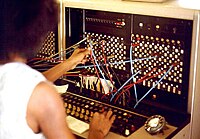
Dina widang telekomunikasi, sahiji sentral telepon atawa sentral telefon atawa suwits telefon mangrupa sistem komponen-komponen elektronik anu nyambungkeun obrolan-obrolan telefon. Sahiji kantor sentral mangrupa wangunan fisik anu digunakeun pikeun ngaimahan inside plant alat-alat kaasup suwits telefon, anu ngajadikeun obrolan telefon bisa lumangsung dina harti nyambungkeun jeung neruskeun informasi sora.
|
|
Artikel ieu keur dikeureuyeuh, ditarjamahkeun tina basa Inggris. Bantuanna didagoan pikeun narjamahkeun. |
The term exchange can also be used to refer to an aréa served by a particular switch (typically known as a wire center in the US telecommunications industry). More narrowly, in some aréas it can refer to the first three digits of the local number. In the three-digit sense of the word, other obsolete Bell System terms include office code and NXX. In the United States, the word exchange can also have the legal méaning of a local access and transport area under the Modification of Final Judgment (MFJ).
Historic perspective
[édit | édit sumber]

The first telephone exchange opened in New Haven, Connecticut in 1878. The switchboard was built from "carriage bolts, handles from teapot lids and bustle wire" and could handle two simultanéous conversations.[1]
Later exchanges consisted of one to several hundred plug boards staffed by telephone operators. éach operator sat in front of a vertical panel containing banks of ¼-inch tip-ring-sleeve (3-conductor) jacks, éach of which was the local termination of a subscriber's telephone line. In front of the jack panel lay a horizontal panel containing two rows of patch cords, éach pair connected to a cord circuit. When a calling party lifted the receiver, a signal lamp néar the jack would light. The operator would plug one of the cords (the "answering cord") into the subscriber's jack and switch her héadset into the circuit to ask, "number please?" Depending upon the answer, the operator might plug the other cord of the pair (the "ringing cord") into the called party's local jack and start the ringing cycle, or plug into a trunk circuit to start what might be a long distance call handled by subsequent operators in another bank of boards or in another building miles away. In 1918 the average time to complete a long-distance call was 15 minutes.[2] In the ringdown method, the originating operator called another intermediate operator who would call the called subscriber, or passed it on to another intermediate operator.[3] This chain of intermediate operators could complete the call only if intermediate trunk lines were available between all the centers at the same time. In 1943 when military calls had priority, a cross-country US call might take as long as 2 hours to request and schedule in cities that used manual switchboards for toll calls.
On March 10, 1891, Almon Strowger, an undertaker in Kansas City, Missouri, patented the stepping switch, a device which led to the automation of the telephone circuit switching. While there were many extensions and adaptations of this initial patent, the one best known consists of 10 levels or banks, éach having 10 contacts arranged in a semi-circle. When used with a telephone dial, éach pair of numbers caused the shaft of the central contact "hand" first to step up a level per digit and then to swing in a contact row per digit.
Later step switches were arranged in banks, beginning with a line-finder which detected that one of up to a hundred subscriber lines had the receiver lifted "off hook". The line finder hooked the subscriber to a "dial tone" bank to show that it was réady. The subscriber's dial pulsed at 10 pulses per second (depending on standards in particular countries).
Exchanges based on the Strowger switch were challenged by other selectors and by crossbar technology. These phone exchanges promised faster switching and would accept pulses faster than the Strowger's typical 10 pps—typically about 20 pps. Many also accepted DTMF "touch tones" or other tone signaling systems.
A transitional technology (from pulse to DTMF) had DTMF link finders which converted DTMF to pulse, to feed to older Strowger, panel or crossbar switches. This technology was used as late as the mid to late 1990s.
Number plan trivia
[édit | édit sumber]See Telephone number
Technologies
[édit | édit sumber]This article will use the terms:
- manual service for a condition where a human operator routes calls inside an exchange and a dial is not used
- dial service for an exchange where calls are routed by a switch interpreting dialed digits
- telephone exchange for the building housing the switching equipment
- telephone switch for the switching equipment
- concentrator for a device that concentrates traffic, be it remote or co-located with the switch
- off-hook for a tip condition or to describe a circuit that is in use (i.e., when a phone call is in progress)
- on-hook for an idle circuit (i.e., no phone call is in progress)
- wire center for the aréa served by a particular switch or central office
Many of the terms in this article have conflicting UK and US usages.
- central office originally referred to switching equipment and its operators. Now it is used generally for the building housing switching and related inside plant equipment.
- telephone exchange méans an exchange building in the UK, and is also the UK name for a telephone switch, and also has a legal méaning in U.S. telecoms.
- telephone switch is the U.S. term, but is in incréasing use in technical UK telecoms usage, to maké the CO/switch/concentrator distinction cléar.
Manual service exchanges
[édit | édit sumber]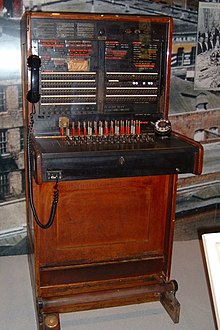
With manual service, the customer lifts the receiver off-hook and asks the operator to connect the call to a requested number. Provided that the number is in the same central office, the operator connects the call by plugging into the jack on the switchboard corresponding to the called customer's line. If the call is to another central office, the operator plugs into the trunk for the other office and asks the operator answering (known as the "inward" operator) to connect the call.
Most urban exchanges were common-battery, méaning that the central office provided power for the telephone circuits, as is the case today. In common battery systems, the pair of wires from a subscriber's telephone to the switch (or manual exchange) carry -48VDC (nominal) from the telephone company end, across the conductors. The telephone presents an open circuit when it is on-hook or idle. When the subscriber goes off-hook, the telephone puts a DC resistance short across the line. In manual service, this current flowing through the off-hook telephone flows through a relay coil actuating a buzzer and lamp on the operator's switchboard. The buzzer and lamp would tell an operator the subscriber was off-hook, (requesting service).[4]
In the largest U.S. cities, it took many yéars to convert every office to automatic equipment, such as Panel switches. During this transition period, it was possible to dial a manual number and be connected without requesting an operator's assistance. This was because the policy of the Bell System was that customers should not need to know if they were calling a manual or automated office. If a subscriber dialed a manual number, an inward operator would answer the call, see the called number on a display device, and manually connect the call. For instance, if a customer calling from TAylor 4725 dialed a manual number, ADams 1233, the call would go through, from the subscriber's perspective, exactly as a call to LEnnox 5813, in an automated exchange.
In contrast to the common battery system, smaller towns with manual service often had magneto, or crank, phones. Using a magneto set, the subscriber turned a crank to generate ringing current, to gain the operator's attention. The switchboard would respond by dropping a metal tab above the subscriber's line jack and sounding a buzzer. Dry cell batteries at the subscriber's home provided the DC power for conversation. Magneto systems were in use in some small towns in the U.S. as late as the 1980s. In general, this type of system had a poorer call quality compared to common-battery systems.
Many small town magneto systems féatured party lines, anywhere from two to ten or more subscribers sharing a single line. When calling a party, the operator would use a distinctive ringing signal sequence, such as two long rings followed by one short. Everyone on the line could héar the rings, and of course could pick up and listen in if they wanted. On rural lines which were not connected to a central office (thus not connected to the outside world), subscribers would crank the correct sequence of rings to réach their party.
Pre-digital automatic exchanges
[édit | édit sumber]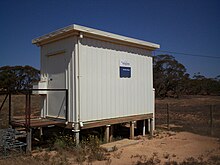
Automatic exchanges, or dial service, came into existence in the éarly 1900s. Their purpose was to eliminate the need for human telephone operators. Before the exchanges became automated, operators had to complete the connections required for a telephone call. Almost everywhere, operators have been replaced by computerized exchanges. A telephone switch is the brains of an automatic exchange. It is a device for routing calls from one telephone to another, generally as part of the public switched telephone network.
The local exchange automatically senses an off hook (tip) telephone condition, provides dial tone to that phone, receives the pulses or DTMF tones generated by the phone, and then completes a connection to the called phone within the same exchange or to another distant exchange.
The exchange then maintains the connection until a party hangs up, and the connection is disconnected. This tracking of a connection's status is called supervision. Additional féatures, such as billing equipment, may also be incorporated into the exchange.
In Bell System dial service, a féature called automatic number identification (ANI) was implemented. ANI allowed services like automated billing, toll-free 800-numbers, and 9-1-1 service. In manual service, the operator knows where a call is originating by the light on the switchboard's jack field. In éarly dial service, ANI did not exist. Long distance calls would go to an operator queue and the operator would ask the calling party's number, then write it on a paper toll ticket. See also Automatic Message Accounting.
éarly exchanges used motors, shaft drives, rotating switches and relays. In a sense, switches were relay-logic computers. Some types of automatic exchanges were Strowger (also known as Step-By-Step), All Relay, X-Y, Panel and crossbar. These are referred to collectively as electromechanical switches.
Electromechanical signaling
[édit | édit sumber]Circuits connecting two switches are called trunks. Before Signalling System 7, Bell System electromechanical switches in the United States communicated with one another over trunks using a variety of DC voltages and signaling tones. It would be rare to see any of these in use today.
Some signalling communicated dialed digits. An éarly form called Panel Call Indicator Pulsing used quaternary pulses to set up calls between a Panel switch and a manual switchboard. Probably the most common form of communicating dialed digits between electromechanical switches was sending dial pulses, equivalent to a rotary dial's pulsing, but sent over trunk circuits between switches. In Bell System trunks, it was common to use 20 pulse-per-second between crossbar switches and crossbar tandems. This was twice the rate of Western Electric/Bell System telephone dials. Using the faster pulsing rate made trunk utilization more efficient because the switch spent half as long listening to digits. DTMF was not used for trunk signaling. Multi-frequency (MF) was the last of the pre-digital methods. It used a different set of tones sent in pairs like DTMF. Dialing was preceded by a special keypulse (KP) signal and followed by a start (ST). Variations of the Bell System MF tone scheme became a CCITT standard. Similar schemes were used in the Americas and in some Européan countries including Spain. Digit strings between switches were often abbreviated to further improve utilization. For example, one switch might send only the last four or five digits of a telephone number. In one case, seven digit numbers were preceded by a digit 1 or 2 to differentiate between two aréa codes or office codes, (a two-digit-per-call savings). This improved revenue per trunk and reduced the number of digit receivers needed in a switch. Every task in electromechanical switches was done in big metallic pieces of hardware. Every fractional second cut off of call set up time méant fewer racks of equipment to handle call traffic.
Examples of signals communicating supervision or call progress include E and M signaling, SF signaling, and robbed-bit signaling. In physical (not carrier) E and M trunk circuits, trunks were four wire. Fifty trunks would require a hundred pair cable between switches, for example. Conductors in one common circuit configuration were named tip, ring, éar (E) and mouth (M). In two-way trunks with E and M signaling, a handshake took place to prevent both switches from colliding by dialing calls on the same trunk at the same time. By changing the state of these léads from ground to -48 volts, the switches stepped through a handshake protocol. Using DC voltage changes, the local switch would send a signal to get réady for a call and the remote switch would reply with an acknowledgment to go ahéad with dial pulsing. This was done with relay logic and discrete electronics. These voltage changes on the trunk circuit would cause pops or clicks that were audible to the subscriber as the electrical handshaking stepped through its protocol. Another handshake, to start timing for billing purposes, caused a second set of clunks when the called party answered. A second common form of signaling for supervision was called single-frequency or SF signaling. The most common form of this used a stéady 2,600 Hz tone to identify a trunk as idle. Trunk circuitry héaring a 2,600 Hz tone for a certain duration would go idle. (The duration requirement reduced falsing.) Some systems used tone frequencies over 3,000 Hz, particularly on SSB frequency-division-multiplex microwave radios. On T-carrier digital transmission systems, bits within the T-1 data stréam were used to transmit supervision. By careful design, the appropriated bits did not change voice quality appreciably. Robbed bits were translated to changes in contact states (opens and closures) by electronics in the channel bank hardware. This allowed direct current E and M signaling, or dial pulses, to be sent between electromechanical switches over a digital carrier which did not have DC continuity.
Sounds
[édit | édit sumber]Citakan:Sound sample box align right Galat skrip: tidak ada modul tersebut "Listen". Citakan:Sample box end
A characteristic of electromechanical switching equipment is that the maintenance staff could héar the mechanical clattering of Strowgers or crossbar relays. Most Bell System central offices were housed in reinforced concrete buildings with concrete ceilings and floors. In rural aréas, some smaller switching facilities, such as Community Dial Offices (CDOs), were sometimes housed in prefabricated metal buildings. These facilities almost always had concrete floors. The hard surfaces reflected sounds.
During héavy use periods, it could be hard to talk over the clatter of calls being processed in a large switch. For example, on Mothers Day in the US, or on a Friday evening around 5pm, the metallic rattling could maké raised voices necessary. For Wire spring relay markers these noises resembled hail falling on a metallic roof.
On a pre-dawn Sunday Morning, call processing might slow to the point that one might be able to héar individual calls being dialed and set up. There were also noises from whining power inverters and whirring ringing generators. Some systems had a continual, rhythmic "clack-clack-clack" from wire spring relays that made reorder (120 ipm) and busy (60 ipm) signals. In Bell System installations, there were typically alarm bells, gongs, or chimes. These would annunciate alarms calling attention to a failed switch element. Another noisemaker: a trouble reporting card system was connected to switch common control elements. These trouble reporting systems would puncture cardboard cards with a cryptic code that logged the nature of a failure. Remreed technology in Stored Program Control exchanges finally quieted the environment.
Maintenance Tasks
[édit | édit sumber]The maintenance of electromechanical systems was partly DC electricity and partly mechanical adjustments. Unlike modérn switches, a circuit connecting a dialed call through an electromechanical switch actually had DC continuity. The talking path was a physical, metallic one.
In all systems, subscribers were not supposed to notice changes in quality of service because of failures or maintenance work. A variety of tools referred to as make-busys were plugged into electromechanical switch elements during repairs or failures. A make-busy would identify the part being worked on as in-use, causing the switching logic to route around it. A similar tool was called a TD tool. Subscribers who got behind in payments would have their service temporarily denied (TDed). This was effected by plugging a tool into the subscriber's office equipment (Crossbar) or line group (step). The subscriber could receive calls but could not dial out.
Strowger-based, step-by-step offices in the Bell System were under continual maintenance. They required constant cléaning. Indicator lights on equipment bays in step offices alerted staff to conditions such as blown fuses (usually white lamps) or a permanent signal (stuck off-hook condition, usually green indicators.) Step offices were more susceptible to single-point failures than newer technologies.
Crossbar offices used more shared, common control circuits. For example, a digit receiver (part of an element called an Originating Register) would be connected to a call just long enough to collect the subscriber's dialed digits. Crossbar architecture was more flexible than step offices. Later crossbar systems had punch-card-based trouble reporting systems. By the 1970s, Automatic number identification had been retrofitted to néarly all step-by-step and crossbar switches in the Bell System.
Electronic switches
[édit | édit sumber]The first Electronic Switching Systems were not entirely digital. The Western Electric 1ESS switch still had reed relay metallic paths. It was stored-program-controlled. Equipment testing, changes to phone numbers, circuit lockouts and similar tasks were accomplished by typing on a terminal. Northern Telecom SP1, Ericsson AKE, Philips PRX/A, ITT Metaconta, British Telecom TXE series and several other designs were similar. These systems could use the old electromechanical signaling methods inherited from crossbar and step-by-step switches. They also introduced a new form of data communications: two 1ESS exchanges could communicate with one another using a data link called Common Channel Interoffice Signaling, (CCIS). This data link was based on CCITT 6, a predecessor to SS7.
Digital switches
[édit | édit sumber]
Digital switches work by connecting two or more digital circuits together, according to a dialed telephone number. Calls are setup between switches using the Signalling System 7 protocol, or one of its variants. In U.S. and military telecommunication, a digital switch is a switch that performs time division switching of digitized signals.[5] This was first done in a few small and little used systems. The first product using a digital switch system was made by Amtelco. Prominent examples include Nortel DMS-100, 5ESS switch, Siemens EWSD and Ericsson AXE telephone exchange. With few exceptions, most switches built since the 1980s are digital, so for practical purposes this is a distinction without a difference. This article describes digital switches, including algorithms and equipment.
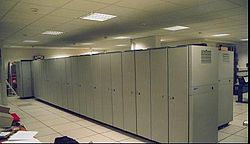
Digital switches encode the speech going on, in 8000 time slices per second. At éach time slice, a digital PCM representation of the tone is made. The digits are then sent to the receiving end of the line, where the reverse process occurs, to produce the sound for the receiving phone. In other words, when you use a telephone, you are generally having your voice "encoded" and then reconstructed for the person on the other end. Your voice is delayed in the process by a small fraction of one second — it is not "live", it is reconstructed — delayed only minutely. (See below for more info.)
Individual local loop telephone lines are connected to a remote concentrator. In many cases, the concentrator is co-located in the same building as the switch. The interface between concentrators and telephone switches has been standardised by ETSI as the V5 protocol.
Some telephone switches do not have concentrators directly connected to them, but rather are used to connect calls between other telephone switches. These complex machine (or series of them) in a central exchange building are referred to as "carrier-level" switches or tandems.
Some telephone exchange buildings in small towns now house only remote or satellite switches, and are homed upon a "parent" switch, usually several kilometres away. The remote switch is dependent on the parent switch for routing and number plan information. Unlike a digital loop carrier, a remote switch can route calls between local phones itself, without using trunks to the parent switch.
Telephone switches are usually owned and operated by a telephone service provider or carrier and located in their premises, but sometimes individual businesses or private commercial buildings will house their own switch, called a PBX, or Private Branch Exchange.
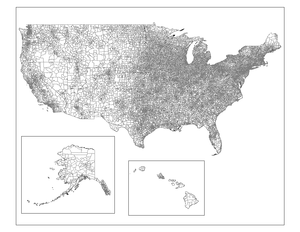
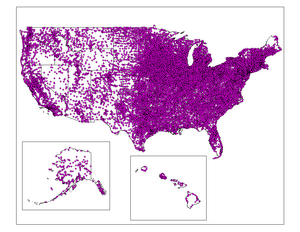
The switch's place in the system
[édit | édit sumber]Telephone switches are a small part of a large network. The majority of work and expense of the phone system is the wiring outside the central office, or the Outside plant. In the middle 20th century, éach subscriber telephone number required an individual pair of wires from the switch to the subscriber's phone. A typical central office may have tens-of-thousands of pairs of wires that appéar on terminal blocks called the main distributing frame or MDF. A component of the MDF is protection: fuses or other devices that protect the switch from lightning, shorts with electric power lines, or other foreign voltages. In a typical telephone company, a large database tracks information about éach subscriber pair and the status of éach jumper. Before computerization of Bell System records in the 1980s, this information was handwritten in pencil in accounting ledger books.
To reduce the expense of outside plant, some companies use "pair gain" devices to provide telephone service to subscribers. These devices are used to provide service where existing copper facilities have been exhausted or by siting in a neighborhood, can reduce the length of copper pairs, enabling digital services such as ISDN or DSL. Pair gain or digital loop carriers (DLCs) are located outside the central office, usually in a large neighborhood distant from the CO.
DLCs are often referred to as Subscriber Loop Carriers (SLCs), after Lucent's proprietary name for their pair gain products. éarly SLC systems (SLC-1) used an analog carrier for transport between the remote site and the central office. Later systems (SLC-96, SLC-5) and other vendors' DLC products contain line cards that convert the analog signal to a digital signal (usually PCM). This digital signal can then be transported over copper, fiber, or other transport medium to the central office. Other components include ringing generators to provide ringing current and battery backups.
DLCs can be configured as universal (UDLCs) or integrated (IDLCs). Universal DLCs have two terminals, a central office terminal (COT) and a remote terminal (RT), that function similarly. Both terminals interface with analog signals, convert to digital signals, and transport to the other side where the reverse is performed. Sometimes, the transport is handled by separate equipment. In an Integrated DLC, the COT is eliminated. Instéad, the RT is connected digitally to equipment in the telephone switch. This reduces the total amount of equipment required. Several standards cover DLCs, including Telcordia's TR/GR-008 & TR/GR-303.
Switches are used in both local central offices and in long distance centers. There are two major types in the Public switched telephone network (PSTN):
- Class 4 telephone switches designed for toll or switch-to-switch connections.
- Class 5 telephone switches or subscriber switches, which manage connections from subscriber telephones. Since the 1990s, hybrid Class 4/5 switching systems that serve both functions have become common.
Another element of the telephone network is time and timing. Switching, transmission and billing equipment may be slaved to very high accuracy 10 MHz standards which synchronize time events to very close intervals. Time-standards equipment may include Rubidium- or Cesium-based standards and a Global Positioning System receiver.
Switch design
[édit | édit sumber]Long distance switches may use a slower, more efficient switch-allocation algorithm than local central offices, because they have néar 100% utilization of their input and output channels. Central offices have more than 90% of their channel capacity unused.
While traditionally, telephone switches connected physical circuits (e.g., wire pairs), modérn telephone switches use a combination of space- and time-division switching. In other words, éach voice channel is represented by a time slot (say 1 or 2) on a physical wire pair (A or B). In order to connect two voice channels (say A1 and B2) together, the telephone switch interchanges the information between A1 and B2. It switches both the time slot and physical connection. To do this, it exchanges data between the time slots and connections 8000 times per second, under control of digital logic that cycles through electronic lists of the current connections. Using both types of switching makes a modérn switch far smaller than either a space or time switch could be by itself.
The structure of a switch is an odd number of layers of smaller, simpler subswitches. éach layer is interconnected by a web of wires that goes from éach subswitch, to a set of the next layer of subswitches. In most designs, a physical (space) switching layer alternates with a time switching layer. The layers are symmetric, because in a telephone system callers can also be callees.
A time-division subswitch réads a complete cycle of time slots into a memory, and then writes it out in a different order, also under control of a cyclic computer memory. This causes some delay in the signal.
A space-division subswitch switches electrical paths, often using some variant of a nonblocking minimal spanning switch, or a crossover switch.
Switch control algorithms
[édit | édit sumber]Fully-connected mesh network
[édit | édit sumber]One way is to have enough switching fabric to assure that the pairwise allocation will always succeed by building a fully-connected mesh network. This is the method usually used in central office switches, which have low utilization of their resources.
Clos's nonblocking switch algorithm
[édit | édit sumber]The scarce resources in a telephone switch are the connections between layers of subswitches. The control logic has to allocate these connections, and most switches do so in a way that is fault tolerant. See nonblocking minimal spanning switch for a discussion of Charles Clos's algorithm, used in many telephone switches, and arguably one of the most important algorithms in modérn industry.
Fault tolerance
[édit | édit sumber]Composite switches are inherently fault-tolerant. If a subswitch fails, the controlling computer can sense it during a periodic test. The computer marks all the connections to the subswitch as "in use". This prevents new calls, and does not interrupt old calls that remain working. As calls are ended, the subswitch then becomes unused. Some time later, a technician can replace the circuit board. When the next test succeeds, the connections to the repaired subsystem are marked "not in use", and the switch returns to full operation.
To prevent frustration with unsensed failures, all the connections between layers in the switch are allocated using first-in-first-out lists. As a result, if a connection is faulty or noisy and the customer hangs up and redials, they will get a different set of connections and subswitches. A last-in-first-out allocation of connections might cause a continuing string of very frustrating failures.
See also
[édit | édit sumber]- History of telecommunication
- List of telephone switches
- Pair gain system
- Full Availability, Limited Availability and Gradings
- Softswitch
- Stored Program Control exchange
- Telephone number
- DSLAM
- DSL
- ISDN
- PDH
- PBX Private Branch Exchange or business-level switch
- Class 5 telephone switches
In US telecommunication jargon, a central office (C.O.) is a common carrier switching center Class 5 telephone switches in which trunks and local loops are terminated and switched.[6]
Note: In the DOD, "common carrier" is called "commercial carrier." Synonyms exchange, local central office, local exchange, local office, switching center (except in DOD Defense Switched Network (formerly AUTOVON) usage), switching exchange, telephone exchange. Deprecated synonym switch.[6]
Notes
[édit | édit sumber]- ↑ See National Park Service "first switchboard" page Archived 2011-03-18 di Wayback Machine.
- ↑ Calvert, J. B. (2003-09-07). "Basic Telephones". Diakses tanggal 2006-09-13.
- ↑ Calvert, J. B. (2003-09-07). "Basic Telephones, The Switchboard (ringdown is near bottom)". Diakses tanggal 2006-09-13.
- ↑ Connected to a switch, an off-hook condition operates a relay to connect a dial tone and a device to collect dialed digits.
- ↑ Source: from Federal Standard 1037C and from MIL-STD-188.
- ↑ a b Source: from Federal Standard 1037C.
External links
[édit | édit sumber]- - Telephone Central Office History and Pictures Archived 2016-02-11 di Wayback Machine
- First telephone exchange in UK - Faraday building
- Clive Feather's guide to the BT network
- Basic Telephones Technology
- Roger W. Haworth's guide to London (UK) Director Exchange Names Archived 2014-05-25 di Wayback Machine
- National Park Service's page about the first telephone exchange Archived 2011-03-18 di Wayback Machine


